The Jacksonville Onslow African-American Heritage Trail is a joint project of Onslow County Tourism, the Onslow County Museum, and the Business Diversity Council of the Jacksonville Onslow Chamber of Commerce. Announced in February 2010, the trail is comprised of historical markers and sites throughout Onslow County that highlight African-American heritage as well as significant individual contributions to the Onslow County community. The initial sites were developed in 2011-2012. Additional historical, cultural and other sites will be identified and added to the Heritage Trail in the future. For information on any upcoming scheduled guided tours, please contact the Jacksonville Onslow Chamber of Commerce.

J1: Linda Richardson Memorial
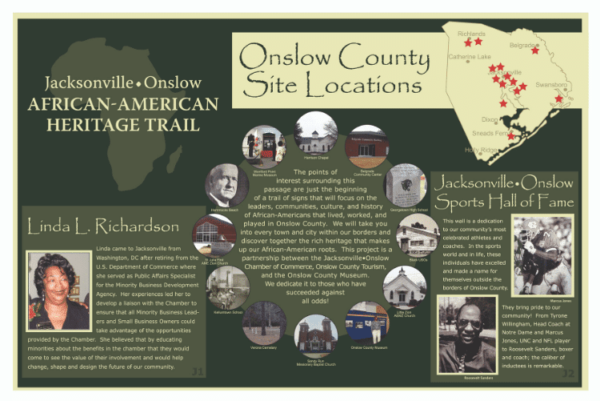
Linda Richardson was instrumental in forming what is now known as the Business Diversity Council of the Jacksonville Onslow Chamber of Commerce in 2008. As a result of her tireless efforts to ensure the success of the program, she gathered a committee of business volunteers to work alongside. She guided their hard work to reach maximum potential. Her vision lives on in this committee as they carry out daily activities and functions towards continued successes she so fervently initiated.
Richardson dedicated 32 years of her life to public service. She began her federal career in 1968 when she was a senior in high school. Richardson worked half days at the Office of Economic Opportunity and the U.S. Department of Health and Human Services. Prior to her tenure with the U.S. Department of Commerce Minority Development Agency she was employed at the U.S. Department of Justice and Treasury, the D.C. Government Office of the Mayor, the U.S. Department of Commerce with the Bureau of Economic Analysis and the Office of Secretary. Her extensive interaction with agencies in the public sector, public affairs, journalism and media coordination positively impacted the minority business community in our nation.
Her vision lives on in this committee as they carry out daily activities and functions towards continued successes she so fervently initiated such as the annual Minority Enterprise Development Week activities.
J2: Georgetown High School
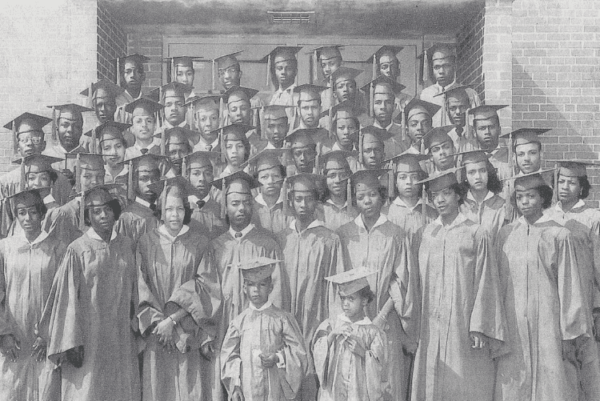
Georgetown High School was the only black high school in Onslow County. It was founded by the Trent River Oakey Grove Missionary Baptist Association in 1908 under the charter "Trent River Oakey Grove Collegiate and Industrial Training School."
School officials deeded the buildings and 2.5 acres to the county for "the education of children of colored race and for that purpose alone," in May 1919.
By the 1930s, the need for a high school was obvious. Federal funds were obtained to construct the new Georgetown High School for $30,000.
J3: Sandy Run
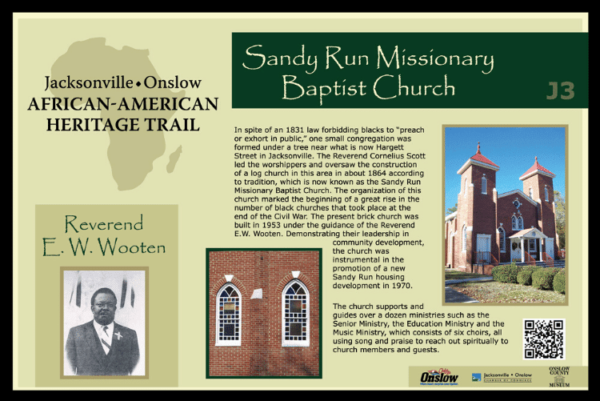
In 1831 there was a law forbidding blacks to "preach or exhort in public." Regardless, a small congregation was formed under a tree near what is now Hargett Street in Jacksonville. Reverend Cornelius Scott led worshippers and oversaw construction of a small log church around 1864. Sandy Run Missionary Baptist Church is the oldest black church on record in the area.
The present brick building was erected under the leadership of Rev. E. W. Wooten in 1953. The church has been instrumental in developing community housing and supports over a dozen ministries to date.
Visit Sandy Run Missionary Baptist to learn more about the church's history and active congregation.
Location: 1503 Hargett Street, Jacksonville
Website: sandyrunmissionarybaptist.com
J4: Belgrade
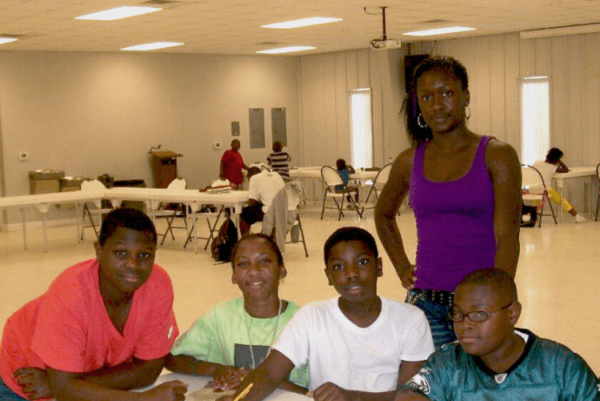
The Belgrade Community Action Association provides a center for Onslow County children, teens and the elderly to build a better community. The association was created in 1970 by a group of concerned citizens and led by Dorothy M. Duncan.
Duncan was an inspirational guiding light for the Belgrade Community Action Association. She led fundraising projects that led to the purchase of 3.5 acres in 1984. The association’s center was built in 1986.
A pavilion was built in 1990 to hold outdoor functions. In 1997 the pavilion was dedicated to Duncan.
The association dreamed of a new facility, and in 2008 their dream came true through fundraising. The center hosts after school programs, tutoring for students, and summer youth programs.
Eldridge Paige became inspired by Duncan and joined the association in 1988. He raised money to build a picnic shelter and the community center building. This was to keep youth programs going. Paige’s fundraising campaigns continue to keep youth involved at the center.
Location: 482 Springhill Road, Maysville
Website: bcaa-nc.org
J5: Verona Loop National Cemetery
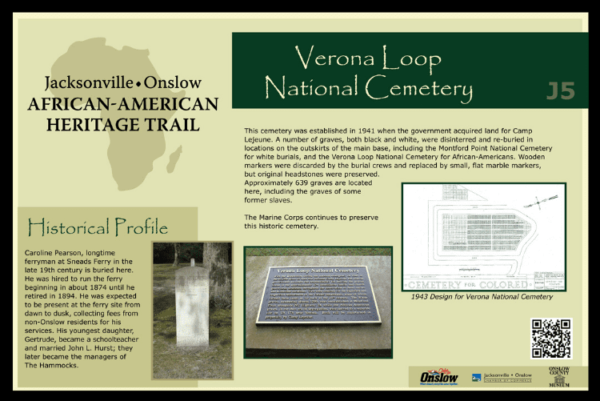
Verona Loop National Cemetery was built for the African-Americans whose bodies were initially buried on Camp Lejeune. Currently, Camp Lejeune takes care of the property. The cemetery is open to the public as a historical site of Onslow County.
This plot near Verona contains the remains of African-Americans, including headstones dating to the early 1800s. Several tombstones are marked with the simple epitaph of a name and the title "slave." The Government placed many simple granite faced tombstones flat in the ground to mark the remains of unknown people. Approximately 639 graves are at the cemetery.
Located just off Hwy 17, approximately 7 miles south of the New River Air Station gate. Marked by a sign that reads: "Marine Corps Camp Lejeune Self Guided Tour: 18"
J6: St. Julia Church
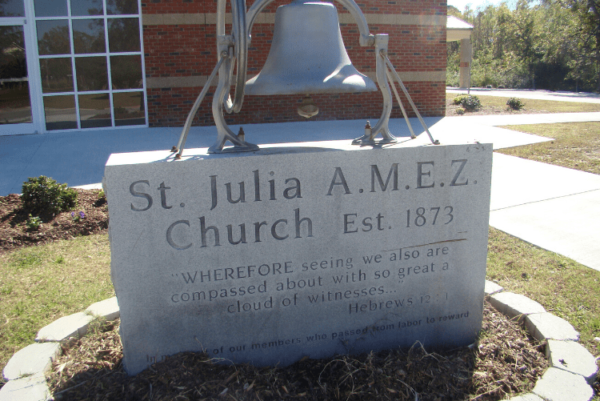
St. Julia A.M.E. Zion Church was formed through the merging of two AME Zion congregations. The church has a history of pursuing freedom. Property lots were purchased in 1873 for the original building, but it was destroyed in a fire during the early 1940s. A brick building was completed in 1944. The church was named "Julia's Temple" after the wife of Bishop Elijah J. Madison, Mrs. Julia Mosely Madison. It eventually became known as "St. Julia."
See the congregation's original "freedom bell" that remains in front of the new sanctuary. It represents freedom... of faith, of speech, and of religion.
Location: 112 Kerr Street, Jacksonville
Website: stjuliaamezion.org
J7: Montford Point Marine Museum

The National Montford Point Marine Museum was established to preserve the legacy of the Montford Point Marines. The museum was designed to collect, record, preserve and display the largest collection of photos, documents, papers and artifacts of the Montford Point Marines.
The museum's mission is to forever capture the unique history of African American Marines from 1942 to 1949.
The Marines of Montford Point entered through its main gate as mere men of color, who had pride, courage and dedication. During the 1940s these men traveled a road that was not paved. They graduated to become Marines and brought the American people and the U.S. Marine Corps into a new era. Today many of the Marines who traveled through this groundbreaking period of American and Marine Corps history have contributed their life's successes to the pain, sacrifices, and rewards that were earned at Montford Point.
The national museum is housed on the hollowed grounds of Montford Point Camp in the East Wing of building M101, Marine Corps Base Camp Johnson, Jacksonville, NC.
Open Tuesdays - Thursdays 10:00 a.m. to 5:00 p.m and 2nd & 4th Saturday 10:00 a.m. to 3:00 p.m. Other times will be made available by appointment. Please email the Museum Director or call (910) 554-0808.
Location: Building M101, Marine Corps Base, Camp Gilbert H. Johnson, Jacksonville
The sign has been relocated to Lejeune Memorial Gardens. 911 Lejeune Blvd., Jacksonville
J8: African American USO
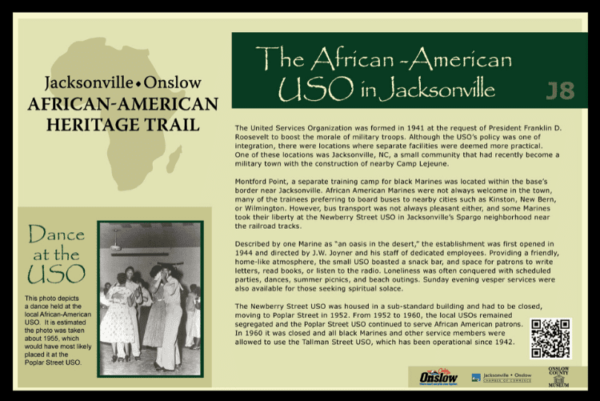
The USO was formed in 1941. USO's carred an integration policy but some locations maintained separate facilities. Jacksonville was one of those locations. Jacksonville had only recently become a military town. Montford Point was established as a separate training camp for black Marines located near Camp Lejeune.
African-American Marines would either travel to nearby cities or take their liberty at the Newberry Street USO. In 1952, the Newberry Street USO was closed and moved to Poplar Street. It operated on Poplar Street until 1960. That same year the Poplar Street USO was closed. All Marines and service members were permitted to use the Tallman Street USO. The Tallman Street USO had been operating since 1942.
J9: Kellumtown
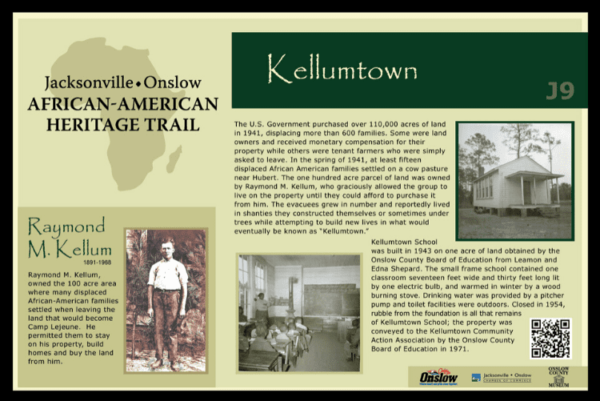
Kellumtown School was built in 1943 on one acre of land. The small frame school contained one classroom lit by an electric bulb. The school was warmed by a wood stove in the winter. Drinking water came from a pitcher pump.
The school served the African-American residents of Kellumtown. These residents were mostly displaced tenant farmers whose land was taken by the government to establish Camp Lejeune in 1941. The school was closed in 1954. Rubble from the foundation is all that remains of the original structure.
J10: Lillian Parker Willingham
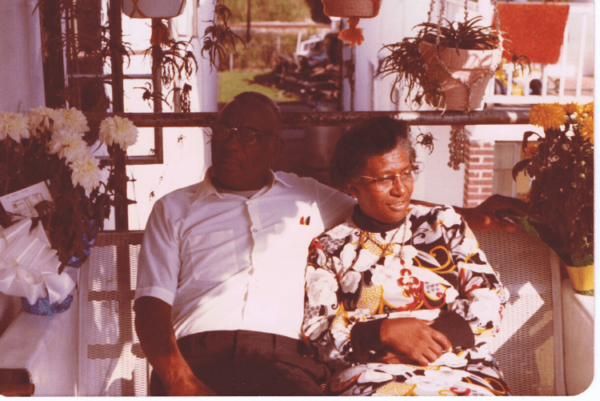
Lillian Parker Willingham has the distinction of being the first African American woman to serve on the Onslow County School Board as well to run for Onslow County Commissioner.
J11: Voting Rights Task Force
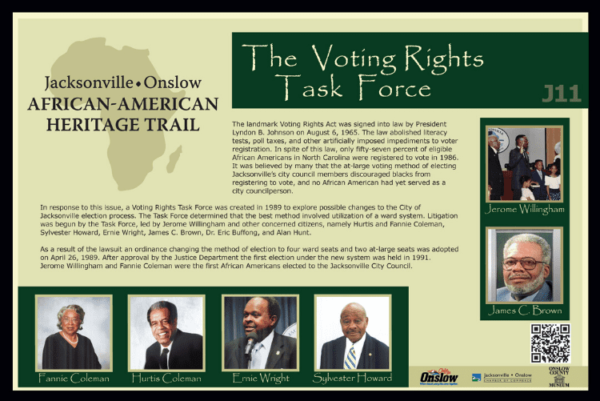
The landmark Voting Rights Act was signed into law by President Lyndon B. Johnson on August 6, 1965. The law abolished literacy tests, poll taxes, and other artificially imposed impediments to voter registration. In spite of this law, only fifty-seven percent of eligible African Americans in North Carolina were registered to vote in 1986. It was believed by many that the at-large voting method of electing Jacksonville's city council members discouraged blacks from registering to vote, and no African American had yet served as a city councilperson.
In response to this issue, a Voting Rights Task Force was created in 1989 to explore possible changes to the City of Jacksonville election process. The Task Force determined that the best method involved utilization of a ward system. Litigation was begun by the Task Force, led by Jerome Willingham and other concerned citizens, namely Hurtis and Fannie Coleman, Sylvester Howard, Ernie Wright, James C. Brown, Dr. Eric Buffong, and Alan Hunt.
As a result of the lawsuit an ordinance changing the method of election to four ward seats and two at-large seats was adopted on April 26, 1989. After approval by the Justice Department the first election under the new system was held in 1991.
Jerome Willingham and Fannie Coleman were the first African Americans elected to the Jacksonville City Council.
J12: Tyrone Willingham
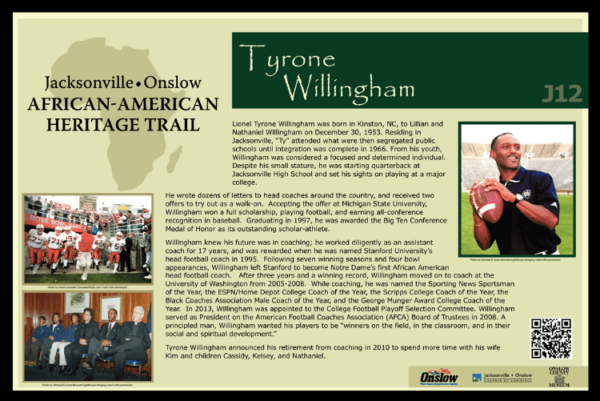
Lionel Tyrone Willingham had seven winning seasons and four bowl appearances while head football coach at Stanford University. He left Stanford to become Note Dame's first African American head football coach.
J13: First Baptist of Belgrade

In 1912, the First Missionary Baptist Church of Belgrade congregation founded the church originally located in “Hickory Hill” and later relocated to its present location on the “South Lawn.” The small congregation grew under the leadership of Reverend Richard Gaskins who served the church from 1912 until 1930. Others followed who continued the growth for decades, Reverend A.H. Dudley 1930-1944 and Reverend V.A. White, who led the church for 38 years (1944-1982). Nine faithful souls began a ministry under Reverend White’s direction and began the processing of building a new place of worship in 1953. This was done with the belief knowing that, “all things were possible with the help of God.” They made many sacrifices and toiled countless hours to complete the sanctuary. On the first Sunday in May 1960, the congregation held their first service in the new sanctuary giving praise to God for the completion of the project.

R1: Onslow County Museum
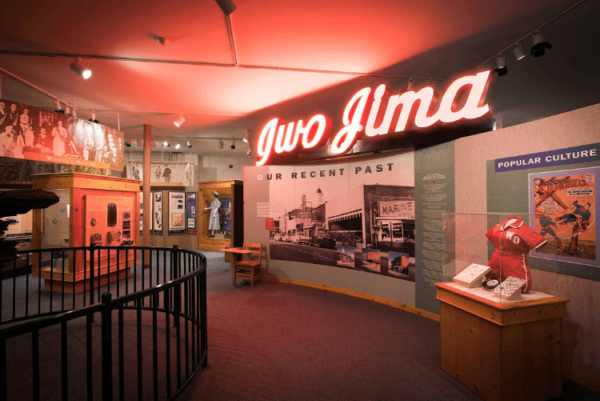
The Onslow County Museum takes pride in researching and recording African-American stories. This is part of the museum's ongoing mission.
An audio-history project is underway to create voice recordings of the memories of local African-American citizens. This project is designed to preserve recollections and broaden the understanding of African-American history in Onslow County.
Visit the museum to learn more about this project and the history of Onslow County.
Location: 301 South Wilmington Street, Richlands
Website: onslowcountymuseum.org
R2: Harrison Chapel
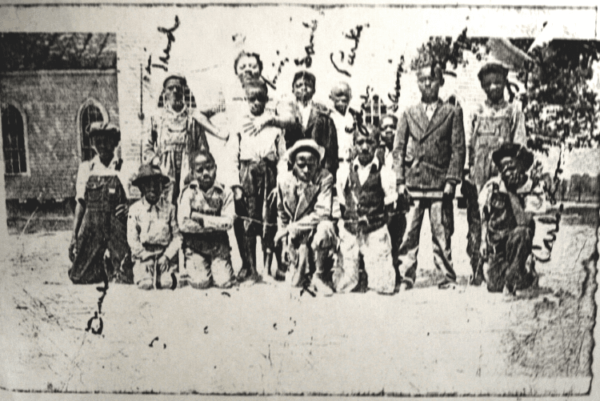
The Harrison Chapel A.M.E. Church transformed from a brush-arbor meeting place in the late 1800s to the well-preserved early 20th century structure. The church has a long heritage of spiritual and community support.
The church created at least 16 parishoners who entered the minstry. The church's tradition of giving back and serving the community continues today. "To Reach the Unreached," is the church's motto. You can hear that motto in every ministry.
Visit Harrison Chapel A.M.E. Church and learn more about its history and role in the community.
Harrison Chapel was used as a school in the 1930s.
R3: Blooming Hill
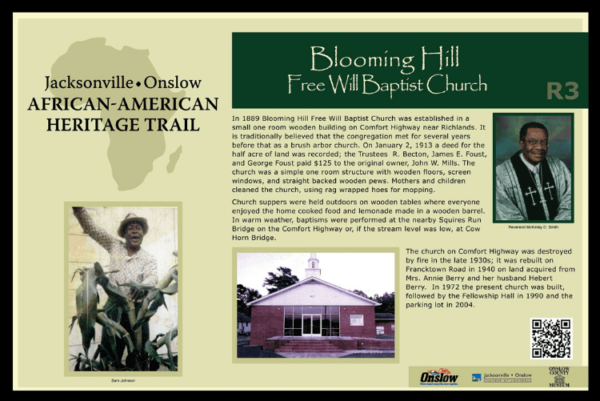
In 1889 Blooming Hill Free Will Baptist Church was established in a small one room wooden building on Comfort Highway near Richlands. It is traditionally believed that the congregation met for several years before that as a brush arbor church. On January 2, 1913 a deed for the half acre of land was recorded; the Trustees R. Becton, James E. Foust, and George Foust paid $125 to the original owner, John W. Mills. The church was a simple one room structure with wooden floors, screen windows, and straight backed wooden pews. Mothers and children cleaned the church, using rag wrapped hoes for mopping. Church suppers were held outdoors on wooden tables where everyone enjoyed the home cooked food and lemonade made in a wooden barrel. In warm weather, baptisms were performed at the nearby Squires Run Bridge on the Comfort Highway or, if the stream level was low, at Cow Horn Bridge.
The church on Comfort Highway was destroyed by fire in the late 1930s; it was rebuilt on Francktown Road in 1940 on land acquired from Mrs. Annie Berry and her husband Hebert Berry. In 1972 the present church was built, followed by the Fellowship Hall in 1990 and the parking lot in 2004.
R4: Edney Chapel
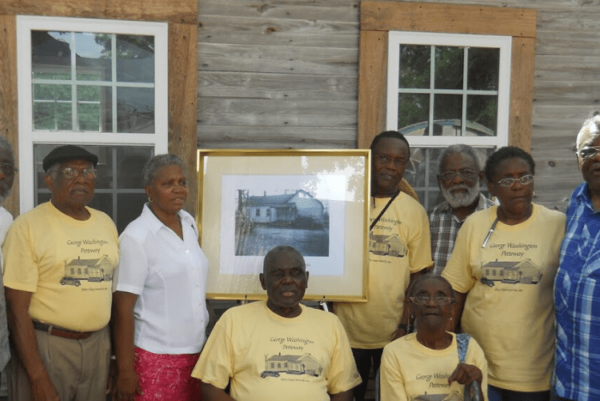
Built in 1879 by former slaves, Mr. George Washington and his wife Mrs. Cecila Ann White Petteway, Edney Chapel School was one of the original schools for African Americans in Onslow County.
Edney Chapel School was established after Mr. Durant H. Rhodes enabled the Rhodestown area children of freed slaves and their descendants to obtain an education as well as religious instruction. The school, that was built by people who had little, but gave so much, encompassed grades 1-7. Edney Chapel School closed its door in 1951 when Woodson School opened in Richlands.
R5: Woodson Elementary
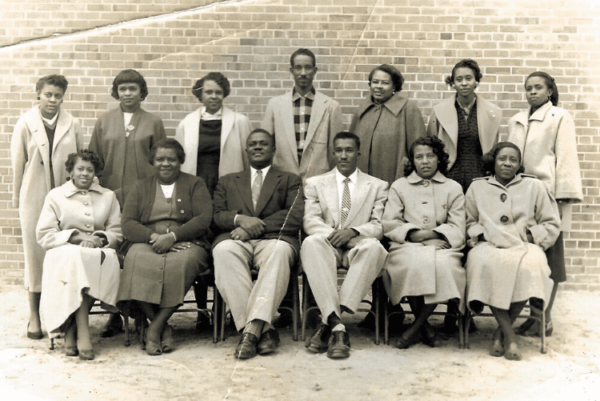
Prior to 1950, African-American school age children attended one or two room schools referred to as community schools in the Richlands area, namely Edney Chapel, Haw Branch, Gum Branch, and the Richlands School. These community schools were closed, and the Carter G. Woodson Elementary School opened. The school was comprised of three buildings housing grades 1-8. After graduation from Woodson Elementary, students were bussed to Georgetown High School in Jacksonville for grades 9-12.
Some of the principals at Woodson were Mr. Wells, Mr. Walter Burton, Mr. Daniel Dicks, and Mr. Robert McRae. Woodson become an integrated elementary school during the mid 1960s with Mr. Robert McRae as principal. Many Richlands natives began their teaching career or gained valuable teaching experience at Woodson Elementary. The school’s administrators, teachers and staff instilled a spirit of excellence in students and inspired academic success.
During the 1972-1973 school year, Carter G. Woodson Elementary School’s three buildings became a part of Richlands High School campus. The cafeteria was used until 1990 before being converted into classrooms. The legacy of Carter G. Woodson High School is still seen in Richlands High School.

S1: Hammocks Beach
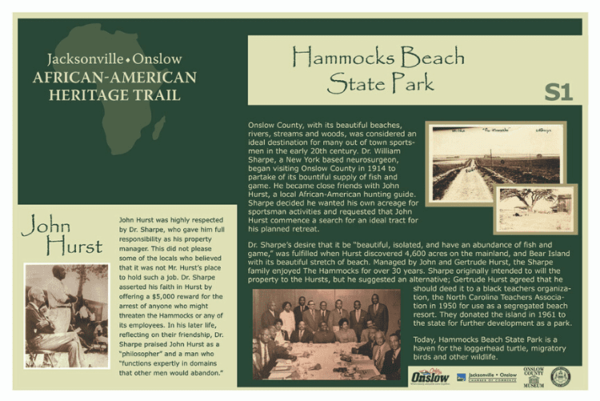
Hammocks Beach State Park was donated to the Black Teacher's Association by Dr. William Sharpe in 1950. It was used for a segregated beach resort until 1961. That same year it was donated to the State of North Carolina for further development as a park.
Dr. Sharpe began visiting Onslow County in 1914. He became close friends with John Hurst, a local African-American hunting and fishing guide. Dr. Sharpe respected Hurst and gave him full responsibility as a property manager at the beach. This did not please some of the locals at the time. Regardless, Dr. Sharpe reaffirmed his faith in Hurst and offered a $5,000 reward for the arrest of anyone who threatened the Hammocks or any of its employees.
Today, Hammocks Beach State Park is a haven for the loggerhead turtle, migratory birds and other wildlife.

SF1: Little Zion African Methodist Episcopal Zion Church
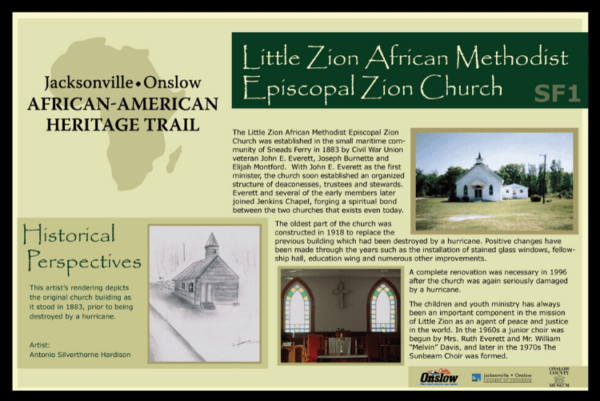
The Little Zion African Methodist Episcopal Zion Church was built in 1883. A hurricane destroyed that building in 1918, leading the the establishment of the second church. There have been several renovations to the church over time, but original parts of the building are still visible.
Little Zion African Methodist Episcopal Church was the first African-American church in Sneads Ferry. The church focused on children, youth and the future. The church is still a center for worship and community ministry. It works in cooperation with other ministries to reach out to the hungry and needy in their community.


TS1: Ocean City
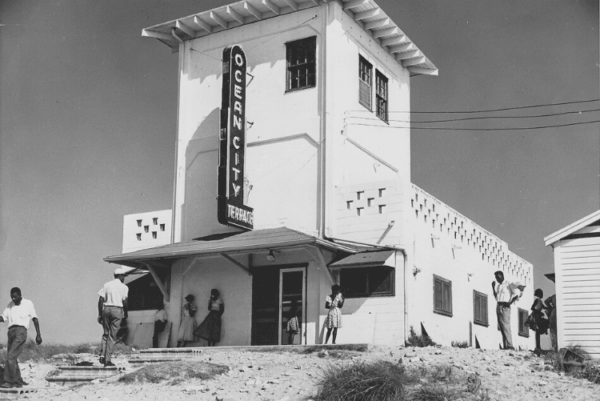
Wilmington attorney and former Mayor Edgar Yow purchased 6 miles of beachfront property on Topsail Island which later became Ocean City Beach, a poplar beach destination for the black community.

 78°F
78°F







